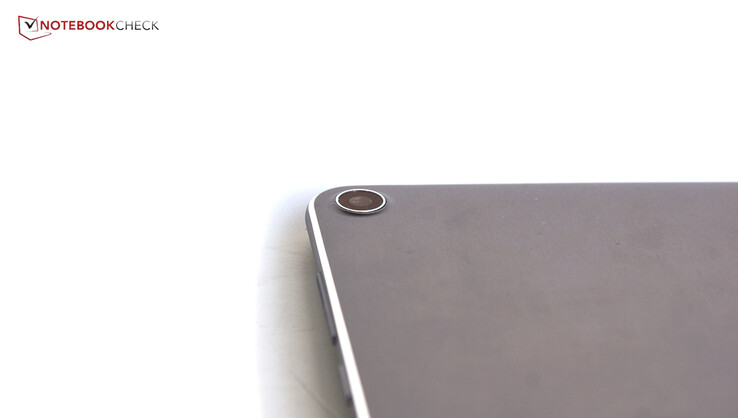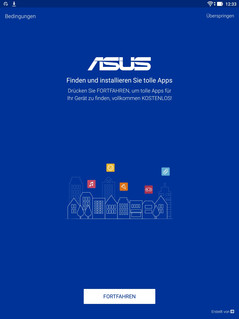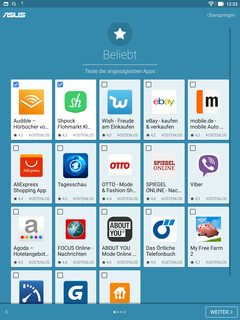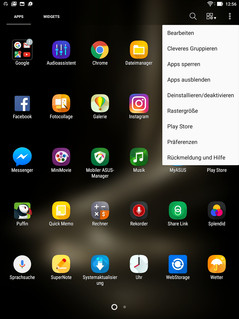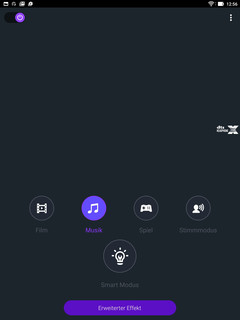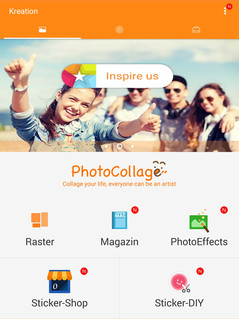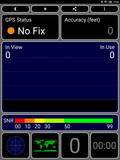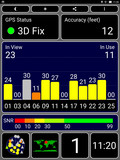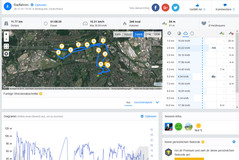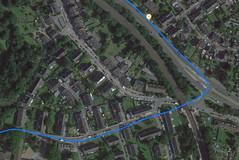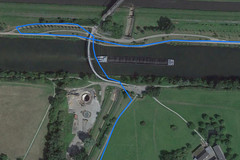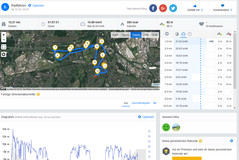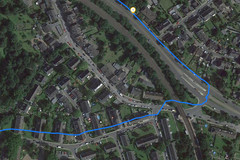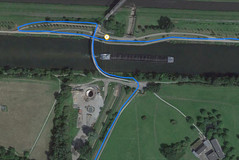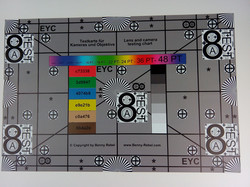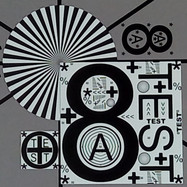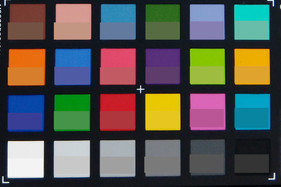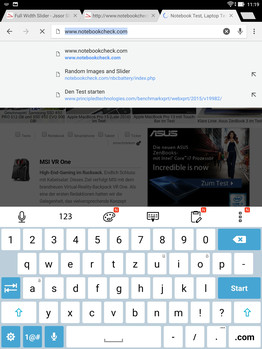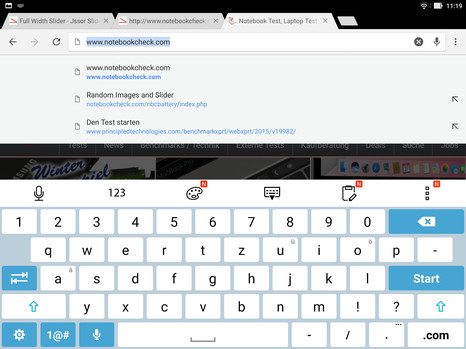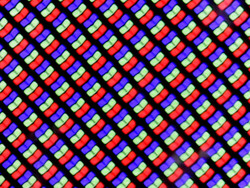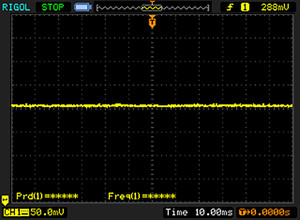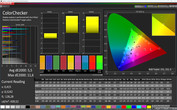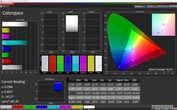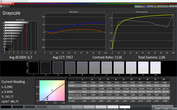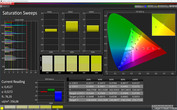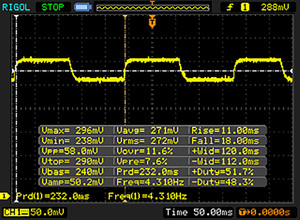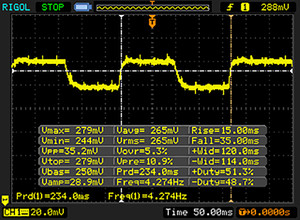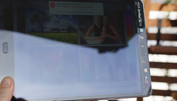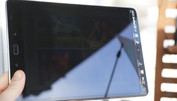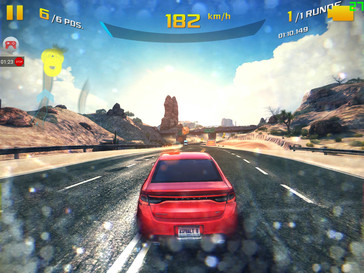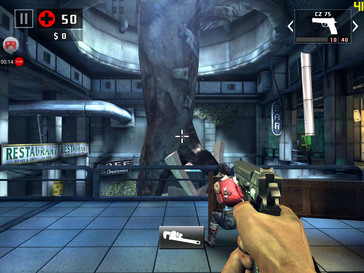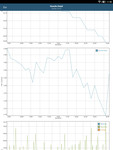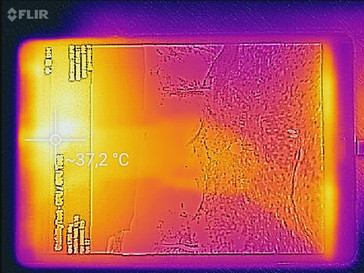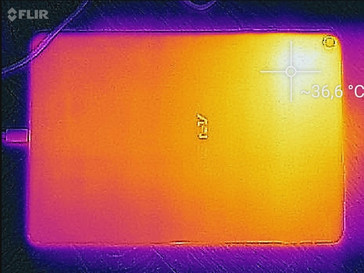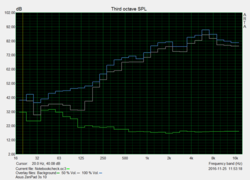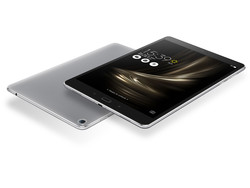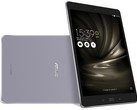Asus ZenPad 3s 10 (Z500M-1H006A) Tablet Review
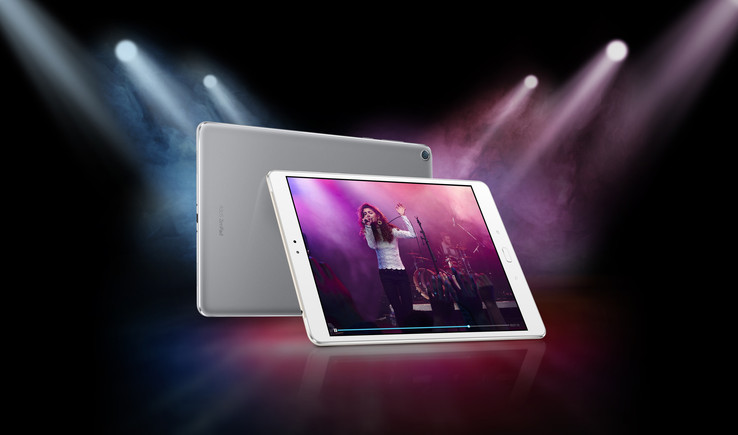
For the original German review, see here.
It seems as if tablets have been stagnating even more than smartphones for some years. There is often a lack of new ideas or features, and the design has not changed much either. Lenovo’s attempts as a pioneer with its Yoga tablets have been quite successful. However, other manufacturers, including Asus, still rely on basic, slim tablets.
Perhaps Asus' ZenPad 3s 10 will be the turning point. We are testing the Z500M-1H006A model with 64 GB of storage. After all, it offers hi-res sound, a high-resolution screen, fingerprint scanner, and stylus support. At a price of below 400 Euros (~$421), it is also much cheaper than an iPad Air 2 with less storage.
Other high-quality, 10-inch tablets are the very expensive Google Pixel C, the Samsung Galaxy Tab S2, the Sony Xperia Z4 tablet, and the Lenovo Yoga Tab 3 Pro.
Case
The casing of Asus' ZenPad 3s 10 is traditional, which is not necessarily a drawback. The tablet looks very elegant; its polished metal frame gleams and the matte metal back shimmers. Our photos show the "gray" model with black front and a somewhat darker back. The "silver" model has a white front and a slightly lighter colored back.
The stability is satisfactory. However, there is some room for improvement in the front's pressure resistance as medium pressure causes temporary blue spots in the liquid crystals. Minor color distortions are visible on the screen when the tablet is twisted, and it also produces audible cracking noises.
With 430 grams (~15.2 oz), Asus' ZenPad 3s 10 is midfield in terms of weight. The iPad Air 2 is 14 grams (~0.5 oz) heavier. Our review sample is quite slim with 5.8 millimeters (~0.23 in). The ZenPad 3s 10 is pleasant to hold, thanks to its rounded edges.
Connectivity
Asus' ZenPad 3s 10 is available with 16, 32 or 64 GB of storage. Apparently, there is no price difference on the Internet at the moment, and thus buyers can opt for the 64 GB model; 52 GB of which can be used. 4 GB of working memory is generous and none of the comparison devices offer this.
Google's Pixel C features a fast USB 3.0/3.1 port. Our review sample is only equipped with a slower USB 2.0 port. A version with mobile Internet is not offered either.
Software
Asus relies on a modified Android 6.0 operating system. However, many of these modifications affect only the looks. Asus calls its interface ZenUI that catches the eye with its strikingly large buttons. Overall, Android has not been changed to such an extent that the user of another Android tablet would not recognize it anymore.
Asus has preloaded many apps. The social media applications Facebook and Instagram are among them. "ZenCircle" is something like Asus' own social network with photos. Photo collages and videos can be created with other preloaded apps. "Puffin" is an alternative browser that is supposed to be particularly fast. Handwritten notes can be made with "SuperNote", and the service app answers questions concerning the tablet as well as providing some self-checks.
Although Asus has preloaded lots of apps, many are quite useful.
Communication and GPS
The ZenPad 3s 10 Z500M offers fast Wi-Fi that operates in the 802.11 a/b/g/n/ac standards. Consequently, 5-GHz networks are supported. The transmission speeds in our standardized test using the Linksys EA8500 reference router are not quite as fast as with other 802.11ac-Wi-Fi devices.
The full signal is still available even a few meters away from the router in the practical test. The reception first decreases to half when three walls and 10 meters separate the device and the router, and websites open much slower.
| Networking | |
| iperf3 transmit AX12 | |
| Dell XPS 13 9360 FHD i5 | |
| OnePlus 3T | |
| Asus ZenPad 3s 10 Z500M | |
| iperf3 receive AX12 | |
| Dell XPS 13 9360 FHD i5 | |
| OnePlus 3T | |
| Asus ZenPad 3s 10 Z500M | |
The incorporated GPS/GLONASS module could not find a signal indoors. It also took very long before it found enough satellites for localization outdoors. However, the accuracy gradually increased up to a decent 4 meters (~13 ft).
For a direct comparison, we took Asus' ZenPad 3s 10 along with Garmin's Edge 500 professional navigation system in our backpacks on a roughly 12-kilometer (~7.5 mi) bike ride. Asus' ZenPad 3s 10 recorded a much shorter distance than Garmin's device. This is probably because it repeatedly drew straight lines between remote measuring points. Although Garmin's system also had a clear dropout in the street behind the railway crossing, it tracked the route considerably more accurately than the tablet when crossing the bridge.
Nevertheless, Asus' tablet should do an overall good job as a free-time navigation system even if it might need longer for connecting to satellites.
Cameras
A rear-facing 8-megapixel and a front-facing 5-megapixel lens are installed in our review sample. The cameras do not have any special features, such as an LED flash. At least both cameras can record Full HD videos.
The photos taken with the primary camera show that the dynamic is not very satisfactory. Both dark areas and very bright areas do not show any outlines, and they are only displayed as black or white areas. This still looks quite romantic in landscape photos, but it is annoying in photos of bright candles. It is also noticeable that the color reproduction is too cool. High-quality smartphone cameras, such as in Samsung's Galaxy S7, present considerably more details even in dark areas. On the other hand, the sharpness of the camera in Asus' ZenPad 3s 10 is acceptable.
The front-facing camera produces quite acceptable photos, and we also liked the dynamics better. However, a visible color noise is soon evident when zoomed slightly.
Preferably, videos should not be made with the tablet. The motion pictures of both cameras make an unquiet, noisy impression, and often omit details such as print.
In addition to practical photography, we look at the tablet in our test studio where all cameras in smartphones and tablet have to photograph the same test picture. The primary camera in the ZenPad 3s 10 Z500M presents clearly frayed edges and has problems displaying clear fonts on a red background. White areas have a color tint. However, the pictures look quite sharp overall.
Visible spots are seen in colored areas in the color comparison. The reproduction of some is also strongly distorted. Black in particular looks more like a medium gray tone.
Accessories and Warranty
Asus does not include any special accessories for the ZenPad 3s 10. At least, it is possible to fold a tablet kickstand with a rubber holder out of a part of the box. All kinds of accessories are offered on Asus' website, but none is product specific. However, many third-party covers and other items for the tablet are offered on the Internet.
An active stylus by Asus that is compatible with the ZenPad 3s 10 is also available on the Internet for approximately 50 Euros (~$53).
A "12" is noted on the warranty card, and thus Asus only gives a 1-year warranty http://www.notebookcheck.com/FAQ-Garantie-Gewaehrleistung-Rueckgaberecht.89911.0.htmlon its tablet. Naturally, this does not affect the manufacturer's legal warranty. Please see our Guarantees, Return Policies & Warranties FAQ for country-specific information.
Input Devices and Handling
The app "SwiftKey" is used as the virtual keyboard, and provides many settings, themes and input options. The keys are clearly lettered and typing on it is easy. Other options, such as gliding over the keyboard or voice input (via Google's voice detection), function well. It is always possible to change to Google's standard app or download another keyboard from the Play Store.
The touchscreen is very accurate and also still functions very precisely in the corners. The fingerprint scanner and menu buttons are outside the screen. The latter could be slightly larger; they are very close to the fingerprint scanner that, unfortunately, does not reactivate the tablet from standby, making it necessary to push the button before unlocking the device via fingerprint.
The grooved keys for volume and standby are on the right, and they are well-palpable and function precisely.
Display
With a resolution of 2048x1536 pixels, Asus' ZenPad 3s 10 is on par with the comparison devices. The 4:3 screen based on IPS technology is also middling in terms of brightness. It shines brighter in the center than at the edges. The illumination of 86% is acceptable, and at most minor brightness differences are visible even in larger colored areas.
| |||||||||||||||||||||||||
Brightness Distribution: 86 %
Center on Battery: 489 cd/m²
Contrast: 1137:1 (Black: 0.43 cd/m²)
ΔE ColorChecker Calman: 5.5 | ∀{0.5-29.43 Ø4.77}
ΔE Greyscale Calman: 6.7 | ∀{0.09-98 Ø5}
Gamma: 2.06
CCT: 7457 K
| Asus ZenPad 3s 10 Z500M IPS, 2048x1536, 9.7" | Apple iPad Air 2 2014 IPS, 2048x1536, 9.7" | Google Pixel C LTPS, 2560x1800, 10.2" | Sony Xperia Z4 Tablet Triluminos display with X-Reality, 2560x1600, 10.1" | Samsung Galaxy Tab S2 9.7 LTE Super AMOLED, 2048x1536, 9.7" | Lenovo Yoga Tab 3 Pro 10 YT3-X90L IPS, 2560x1600, 10.1" | |
|---|---|---|---|---|---|---|
| Screen | 3% | 4% | -20% | 20% | 6% | |
| Brightness middle (cd/m²) | 489 | 423 -13% | 487 0% | 471 -4% | 358 -27% | 429 -12% |
| Brightness (cd/m²) | 443 | 427 -4% | 510 15% | 457 3% | 357 -19% | 434 -2% |
| Brightness Distribution (%) | 86 | 92 7% | 91 6% | 92 7% | 86 0% | 82 -5% |
| Black Level * (cd/m²) | 0.43 | 0.61 -42% | 0.39 9% | 0.46 -7% | 0.35 19% | |
| Contrast (:1) | 1137 | 693 -39% | 1249 10% | 1024 -10% | 1226 8% | |
| Colorchecker dE 2000 * | 5.5 | 2.86 48% | 5.24 5% | 8.69 -58% | 1.78 68% | 4.61 16% |
| Colorchecker dE 2000 max. * | 11.6 | 9.28 20% | ||||
| Greyscale dE 2000 * | 6.7 | 2.37 65% | 7.95 -19% | 11.24 -68% | 1.38 79% | 6.64 1% |
| Gamma | 2.06 107% | 2.43 91% | 2.16 102% | 2.17 101% | 2.24 98% | 2.42 91% |
| CCT | 7457 87% | 6941 94% | 6565 99% | 9508 68% | 6366 102% | 6929 94% |
| Color Space (Percent of AdobeRGB 1998) (%) | 88 | |||||
| Color Space (Percent of sRGB) (%) | 99 |
* ... smaller is better
Screen Flickering / PWM (Pulse-Width Modulation)
| Screen flickering / PWM not detected | |||
In comparison: 53 % of all tested devices do not use PWM to dim the display. If PWM was detected, an average of 8080 (minimum: 5 - maximum: 343500) Hz was measured. | |||
The decent black level of 0.43 cd/m² leads to a good contrast ratio of 1137:1. Subjectively, the colors look relatively vivid on the screen. Asus promises that the contrast adapts dynamically to the image situation and that individual areas are ideally synchronized to achieve a subjectively higher contrast. The Tru2Life technology is supposed to make even sharper images possible. The reproduction looks really sharp subjectively, but not strikingly better than on other high-quality tablets.
Many parameters of the image reproduction can be adapted via the app "Splendid". A blue-light filter can be enabled (the color temperature is simply set to very warm) for minimizing eye strain.
In our test using the CalMAN software and a spectrophotometer we discovered that the reproduction of colors is generally a bit too blue. However, the bluish tint can still be tolerated. The color deviation compared with the sRGB reference color space is also within an acceptable range. The color space coverage of 95.3% will probably be too little for professional users.
Display Response Times
| ↔ Response Time Black to White | ||
|---|---|---|
| 29 ms ... rise ↗ and fall ↘ combined | ↗ 11 ms rise | |
| ↘ 18 ms fall | ||
| The screen shows relatively slow response rates in our tests and may be too slow for gamers. In comparison, all tested devices range from 0.1 (minimum) to 240 (maximum) ms. » 76 % of all devices are better. This means that the measured response time is worse than the average of all tested devices (20.2 ms). | ||
| ↔ Response Time 50% Grey to 80% Grey | ||
| 50 ms ... rise ↗ and fall ↘ combined | ↗ 15 ms rise | |
| ↘ 35 ms fall | ||
| The screen shows slow response rates in our tests and will be unsatisfactory for gamers. In comparison, all tested devices range from 0.165 (minimum) to 636 (maximum) ms. » 86 % of all devices are better. This means that the measured response time is worse than the average of all tested devices (31.6 ms). | ||
The glossy screen is a problem for outdoor use. Content is only legible on the screen to some extent at maximum brightness, and this also becomes difficult in very bright surroundings. The light sensor functions quite well and fast.
The viewing angles are very good thanks to the IPS technology. The image remains legible even from very flat angles, and only very slight brightness shifts are noticed.
Performance
The SoC in Asus' ZenPad 3s 10 Z500M is Mediatek's MT8176, which is relatively new to the market. It has six cores, two of which clock fast and four slower, more efficient cores that share the work.
Generally, the performance of Asus' ZenPad 3s 10 is quite high. Navigating through menus is absolutely smooth and apps are launched quickly. However, our review sample sometimes behaved oddly. Apps crashed, benchmarks refused to start or stopped half way through. It is unclear whether this is due to the SoC or the software. In any case, Asus should provide a software update for eliminating these issues.
The SoC is also conspicuous during some benchmarks, and its performance falls behind its rivals. Then again, it is quite far ahead in other benchmarks. The relatively weak graphics card evidently plays a role here. The PowerVR GX6250 is now over two years old, and it was already mid-range at its release. In any case, the ZenPad 3s 10 has to be satisfied with the last places in the comparison field. Some benchmarks that require OpenGL ES 3.1 or higher launched, but then crashed with the message "Out of Memory" half way through, which seems rather unlikely in view of 4 GB of RAM.
| AnTuTu v6 - Total Score | |
| Apple iPad Air 2 2014 | |
| Google Pixel C | |
| Asus ZenPad 3s 10 Z500M | |
| Lenovo Yoga Tab 3 Pro 10 YT3-X90L | |
| GFXBench (DX / GLBenchmark) 2.7 | |
| T-Rex Onscreen | |
| Apple iPad Air 2 2014 | |
| Google Pixel C | |
| Sony Xperia Z4 Tablet | |
| Samsung Galaxy Tab S2 9.7 LTE | |
| Asus ZenPad 3s 10 Z500M | |
| Lenovo Yoga Tab 3 Pro 10 YT3-X90L | |
| 1920x1080 T-Rex Offscreen | |
| Apple iPad Air 2 2014 | |
| Google Pixel C | |
| Sony Xperia Z4 Tablet | |
| Samsung Galaxy Tab S2 9.7 LTE | |
| Lenovo Yoga Tab 3 Pro 10 YT3-X90L | |
| Asus ZenPad 3s 10 Z500M | |
| GFXBench 3.0 | |
| on screen Manhattan Onscreen OGL | |
| Apple iPad Air 2 2014 | |
| Google Pixel C | |
| Sony Xperia Z4 Tablet | |
| Samsung Galaxy Tab S2 9.7 LTE | |
| Asus ZenPad 3s 10 Z500M | |
| Lenovo Yoga Tab 3 Pro 10 YT3-X90L | |
| 1920x1080 1080p Manhattan Offscreen | |
| Google Pixel C | |
| Apple iPad Air 2 2014 | |
| Sony Xperia Z4 Tablet | |
| Lenovo Yoga Tab 3 Pro 10 YT3-X90L | |
| Samsung Galaxy Tab S2 9.7 LTE | |
| Asus ZenPad 3s 10 Z500M | |
| PCMark for Android - Work performance score | |
| Google Pixel C | |
| Samsung Galaxy Tab S2 9.7 LTE | |
| Lenovo Yoga Tab 3 Pro 10 YT3-X90L | |
| Sony Xperia Z4 Tablet | |
| Asus ZenPad 3s 10 Z500M | |
| Geekbench 4.0 | |
| 64 Bit Single-Core Score | |
| Asus ZenPad 3s 10 Z500M | |
| 64 Bit Multi-Core Score | |
| Asus ZenPad 3s 10 Z500M | |
| Compute RenderScript Score | |
| Asus ZenPad 3s 10 Z500M | |
The zigzag course of Asus' ZenPad 3s 10 continues also in the JavaScript and HTML 5 benchmarks that show the browsing performance. It is sometimes midfield, sometimes it has the lead, while at others, it is in the last place. Stable performance rates are evidently a problem for the review sample. Overall, we also had the feeling that websites sometimes opened quickly and sometimes a bit slower in the practical tests, which confirms these test outcomes. YouTube videos, however, usually load and stream fast, but HTML 5 pages stutter slightly in Chrome 55.
| Octane V2 - Total Score | |
| Apple iPad Air 2 2014 | |
| Lenovo Yoga Tab 3 Pro 10 YT3-X90L | |
| Sony Xperia Z4 Tablet | |
| Google Pixel C | |
| Samsung Galaxy Tab S2 9.7 LTE | |
| Asus ZenPad 3s 10 Z500M | |
| Mozilla Kraken 1.1 - Total | |
| Samsung Galaxy Tab S2 9.7 LTE | |
| Google Pixel C | |
| Lenovo Yoga Tab 3 Pro 10 YT3-X90L | |
| Sony Xperia Z4 Tablet | |
| Asus ZenPad 3s 10 Z500M | |
| Apple iPad Air 2 2014 | |
| WebXPRT 2015 - Overall | |
| Apple iPad Air 2 2014 | |
| Google Pixel C | |
| Lenovo Yoga Tab 3 Pro 10 YT3-X90L | |
| Asus ZenPad 3s 10 Z500M | |
| Sony Xperia Z4 Tablet | |
| Samsung Galaxy Tab S2 9.7 LTE | |
| JetStream 1.1 - Total Score | |
| Asus ZenPad 3s 10 Z500M | |
| Google Pixel C | |
| Samsung Galaxy Tab S2 9.7 LTE | |
| Lenovo Yoga Tab 3 Pro 10 YT3-X90L | |
* ... smaller is better
The storage performance is the last part of our performance chapter. We test the access speeds on both the internal storage and on an external microSD card. Again, very different results are presented with the internal storage: The ZenPad 3s 10 takes the lead on all comparison devices in sequential write, while it falls behind to the last places in random write. However, since the access times are overall good in read and we did not experience extremely long loading times subjectively, we would say that the storage performance is good.
Accessing our Toshiba Exceria Pro M401 microSD reference card was performed at an acceptable speed. However, higher access times are certainly possible with the fast card.
| AndroBench 3-5 | |
| Sequential Read 256KB | |
| Sony Xperia Z4 Tablet | |
| Samsung Galaxy Tab S2 9.7 LTE | |
| Asus ZenPad 3s 10 Z500M | |
| Google Pixel C | |
| Lenovo Yoga Tab 3 Pro 10 YT3-X90L | |
| Sequential Write 256KB | |
| Asus ZenPad 3s 10 Z500M | |
| Google Pixel C | |
| Sony Xperia Z4 Tablet | |
| Lenovo Yoga Tab 3 Pro 10 YT3-X90L | |
| Samsung Galaxy Tab S2 9.7 LTE | |
| Random Read 4KB | |
| Samsung Galaxy Tab S2 9.7 LTE | |
| Asus ZenPad 3s 10 Z500M | |
| Lenovo Yoga Tab 3 Pro 10 YT3-X90L | |
| Sony Xperia Z4 Tablet | |
| Google Pixel C | |
| Random Write 4KB | |
| Sony Xperia Z4 Tablet | |
| Lenovo Yoga Tab 3 Pro 10 YT3-X90L | |
| Google Pixel C | |
| Samsung Galaxy Tab S2 9.7 LTE | |
| Asus ZenPad 3s 10 Z500M | |
| Sequential Read 256KB SDCard | |
| Lenovo Yoga Tab 3 Pro 10 YT3-X90L | |
| Asus ZenPad 3s 10 Z500M | |
| Sequential Write 256KB SDCard | |
| Asus ZenPad 3s 10 Z500M | |
| Lenovo Yoga Tab 3 Pro 10 YT3-X90L | |
Games
A mixed impression is also left in gaming. Basically, the graphics unit should support the effects and improvements from OpenGL 3.1. However, since there were issues in the benchmarks, we assume that games will not utilize these effects for compatibility reasons. The performance is also unsatisfactory: The high resolution prevents "Asphalt 8: Airborne" from running absolutely smoothly in high detail settings. An average of only 26 frames was achieved here.
On the other hand, "Dead Trigger 2" is not limited to 30 frames per second as in other devices, and the game was even rendered at very smooth 59 frames on average. Older and less demanding games, such as "Angry Birds" run without any issues.
Control via touchscreen and position sensor function impeccably.
| Asphalt 8: Airborne | |||
| Settings | Value | ||
| high | 26 fps | ||
| very low | 30 fps | ||
| Dead Trigger 2 | |||
| Settings | Value | ||
| high | 59 fps | ||
Emissions
Temperature
The casing's idle temperatures are inconspicuous at a maximum of 29.7 °C (~85 °F). The temperature increase during full load can be felt, but are in no way unpleasant at a maximum of 38.7 °C (~102 °F). The temperature increase is limited locally and much lower on the back.
We use the battery test of GFXBench to find out whether the device can maintain its performance even during prolonged load as the benchmark logs the frame rates. They only fluctuate slightly at thirty runs, and thus the system performance should remain fairly stable even during prolonged load.
(+) The maximum temperature on the upper side is 38.6 °C / 101 F, compared to the average of 33.6 °C / 92 F, ranging from 20.7 to 53.2 °C for the class Tablet.
(+) The bottom heats up to a maximum of 34.5 °C / 94 F, compared to the average of 33.2 °C / 92 F
(+) In idle usage, the average temperature for the upper side is 27.3 °C / 81 F, compared to the device average of 30 °C / 86 F.
Speakers
Asus is especially proud of the two stereo speakers installed into the lower edge. According to the manufacturer, the sound is impressive thanks to five magnets and all kinds of software support via DTS-HD and 7.1 Virtual Surround. In any case, the maximum volume is impressive, even though the trebles clash very unpleasantly in pop music, regardless of whether audio enhancement is enabled or not. In full orchestra sound, tones are skipped and the sound is no longer absolutely linear. Sometimes, the volume has to be reduced to half to make the sound more pleasant. The speakers are still loud enough then.
We also noticed that system sounds are generally quite loud, for example, the tone that confirms tablet shutdown or the keyboard's typing sound. We would recommend users with sensitive ears to adapt this manually at initiation.
It is quite possible to listen to higher-quality soundtracks since the tablet supports hi-res audio files. A special improvement for headphones via DTS X Headphone is also on-board. In fact, the sound via headphones or external speakers is good regardless of whether they are connected via cable or Bluetooth.
Asus ZenPad 3s 10 Z500M audio analysis
(+) | speakers can play relatively loud (95 dB)
Bass 100 - 315 Hz
(-) | nearly no bass - on average 24% lower than median
(+) | bass is linear (5% delta to prev. frequency)
Mids 400 - 2000 Hz
(±) | reduced mids - on average 5.4% lower than median
(+) | mids are linear (4.2% delta to prev. frequency)
Highs 2 - 16 kHz
(±) | higher highs - on average 5.7% higher than median
(+) | highs are linear (5.3% delta to prev. frequency)
Overall 100 - 16.000 Hz
(±) | linearity of overall sound is average (18.4% difference to median)
Compared to same class
» 48% of all tested devices in this class were better, 6% similar, 46% worse
» The best had a delta of 7%, average was 20%, worst was 129%
Compared to all devices tested
» 40% of all tested devices were better, 8% similar, 52% worse
» The best had a delta of 4%, average was 24%, worst was 134%
Google Pixel C audio analysis
(+) | speakers can play relatively loud (92.8 dB)
Bass 100 - 315 Hz
(-) | nearly no bass - on average 29.9% lower than median
(±) | linearity of bass is average (7.5% delta to prev. frequency)
Mids 400 - 2000 Hz
(+) | balanced mids - only 4.8% away from median
(±) | linearity of mids is average (7% delta to prev. frequency)
Highs 2 - 16 kHz
(±) | higher highs - on average 7.5% higher than median
(±) | linearity of highs is average (8.6% delta to prev. frequency)
Overall 100 - 16.000 Hz
(±) | linearity of overall sound is average (24.2% difference to median)
Compared to same class
» 75% of all tested devices in this class were better, 6% similar, 19% worse
» The best had a delta of 7%, average was 20%, worst was 129%
Compared to all devices tested
» 72% of all tested devices were better, 6% similar, 22% worse
» The best had a delta of 4%, average was 24%, worst was 134%
Frequency diagram in comparison (checkboxes above can be turned on/off!)
Energy Management
Power Consumption
The ZenPad 3s 10 is quite economical with power. It consumes a maximum of 4.23 watts when idling, and at most 11.58 watts during load. Then again, the average load consumption of over 10 watts is relatively high.
| Off / Standby | |
| Idle | |
| Load |
|
Key:
min: | |
| Asus ZenPad 3s 10 Z500M 5900 mAh | Apple iPad Air 2 2014 mAh | Google Pixel C mAh | Samsung Galaxy Tab S2 9.7 LTE 5870 mAh | Lenovo Yoga Tab 3 Pro 10 YT3-X90L 6200 mAh | |
|---|---|---|---|---|---|
| Power Consumption | 1% | -6% | -10% | -169% | |
| Idle Minimum * (Watt) | 1.59 | 1.2 25% | 1.82 -14% | 2.3 -45% | 8.6 -441% |
| Idle Average * (Watt) | 4.14 | 5.1 -23% | 4.26 -3% | 4.5 -9% | 11.26 -172% |
| Idle Maximum * (Watt) | 4.23 | 5.4 -28% | 4.33 -2% | 5 -18% | 11.3 -167% |
| Load Average * (Watt) | 10.89 | 7.9 27% | 9.82 10% | 9.4 14% | 14.57 -34% |
| Load Maximum * (Watt) | 11.58 | 11.1 4% | 13.99 -21% | 10.4 10% | 14.9 -29% |
* ... smaller is better
Battery Runtime
The battery in Asus' ZenPad 3s 10 Z500M can provide 22 Wh. This enables the tablet to achieve 8:38 hours in the practical Wi-Fi test. Google's Pixel C manages a much longer runtime and the iPad Air 2 also achieves a few extra minutes. However, we tested the latter using our former procedure that was not as demanding.
In practice, the ZenPad 3s 10 can certainly last an entire workday, with some reserves afterward. If not used constantly, it might even last two days and even four days of occasional use are not unrealistic.
The battery is recharged by approximately 25% within half an hour via Quick Charge. It then progresses slower so that up to 2.5 hours can be expected for a full recharge.
| Asus ZenPad 3s 10 Z500M 5900 mAh | Apple iPad Air 2 2014 mAh | Google Pixel C mAh | Sony Xperia Z4 Tablet mAh | Samsung Galaxy Tab S2 9.7 LTE 5870 mAh | Lenovo Yoga Tab 3 Pro 10 YT3-X90L 6200 mAh | |
|---|---|---|---|---|---|---|
| Battery runtime | -7% | 30% | 10% | -6% | 11% | |
| Reader / Idle (h) | 24.2 | 22.7 -6% | 34.8 44% | 35.6 47% | 15.3 -37% | 21 -13% |
| H.264 (h) | 10 | 9.4 -6% | 12.3 23% | 11.8 18% | 10.9 9% | 10.7 7% |
| WiFi v1.3 (h) | 8.6 | 10.6 23% | 8.8 2% | 6.6 -23% | 9.3 8% | |
| Load (h) | 3.8 | 3.5 -8% | 4.9 29% | 2.8 -26% | 4.9 29% | 5.4 42% |
| WiFi (h) | 10.5 |
Pros
Cons
Verdict
Stable, high-quality, good screen, decent speakers, useful battery life - Asus' ZenPad 3s 10 does not present any major shortcomings in our test course. However, we are not quite sure whether or not the review sample impressed us. The speaker sound alongside all its sound enhancing software and the hi-res support is loud, but it sounds much better on paper than in real life. The cameras' low dynamics in bright and dark areas will not awe anyone either.
However, the strangest thing is the SoC's behavior that sometimes provided the best performance and then dropped again to the other extreme - not everything runs smoothly in everyday use. Perhaps a software update will improve this behavior. The very loud system sounds that often can only be reduced in volume or turned off in hidden menus are also annoying. Furthermore, there are many preloaded apps that some users will probably never activate.
Basically, purchasing Asus' ZenPad 3s 10 Z500M is not a bad decision: The buyer gets a solid tablet with a competitive screen and good casing. However, many minor annoyances in details prevent real enthusiasm.
Can we give Asus' ZenPad 3s 10 a purchase recommendation? It depends: It certainly offers many aspects for its price that an iPad Air 2 could not do much better, and it can even compete with the considerably more expensive Google Pixel C in many sections. The buyer will get a relatively useful tablet for everyday use if not too much is expected from the speakers or one does not depend too much on performance.
Asus ZenPad 3s 10 Z500M
- 12/25/2016 v6 (old)
Florian Wimmer


